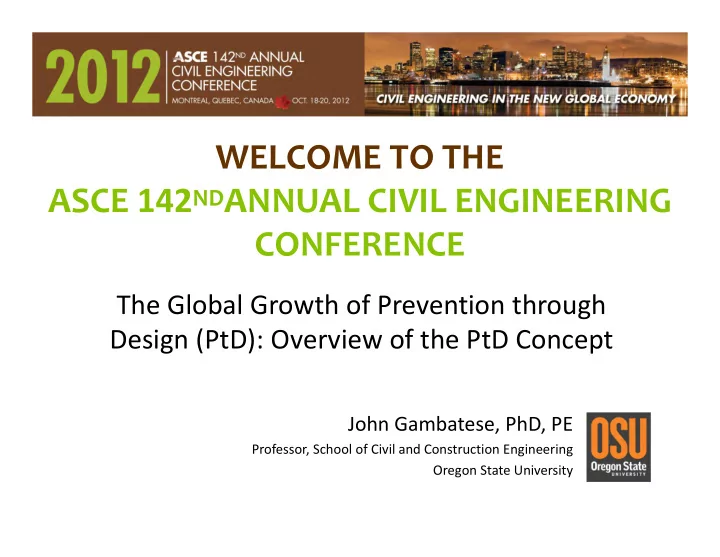

WELCOME TO THE ASCE 142 ND ANNUAL CIVIL ENGINEERING CONFERENCE The Global Growth of Prevention through Design (PtD): Overview of the PtD Concept John Gambatese, PhD, PE Professor, School of Civil and Construction Engineering Oregon State University
What is Prevention through Design (PtD)? “Addressing occupational safety and health needs in the design process to prevent or minimize the work ‐ related hazards and risks associated with the construction, manufacture, use, maintenance, and disposal of facilities, materials, and equipment.” (http://www.cdc.gov/niosh/topics/ptd/)
PtD in Construction is… • Explicitly considering construction safety in the design of a project. • Making design decisions based in part on a project's inherent safety risk to construction workers. • Addressing worker safety in the constructability review process. “Safety Constructability” (Source: www.designforconstructionsafety.org)
Why PtD in Construction? • 22% of 226 injuries that occurred from 2000 ‐ 2002 in Oregon, WA, and CA 1 • 42% of 224 fatalities in US between 1990 ‐ 2003 1 • 60% of fatal accidents resulted in part from decisions made before site work began 2 • 63% of all fatalities and injuries could be attributed to design decisions or lack of planning 3 1 Behm, M., “Linking Construction Fatalities to the Design for Constr. Safety Concept” (2005) 2 European Foundation for the Improvement of Living and Working Conditions 3 NSW WorkCover, CHAIR Safety in Design Tool , 2001
Additional Motivations • Moral and ethical standards “Engineers shall recognize that the lives, safety, health and welfare of the general public are dependent upon engineering decisions ….” (ASCE Code of Ethics) • ASCE Policy Statement 350 Environmental • Sustainability Sustainability Economic Social
Additional Motivations PtD Hierarchy of Controls Elimination Higher Eliminate the hazard during design Substitution Reliability of Control Substitute a less ‐ hazardous material or form during design Engineering Controls “Design ‐ in” engineering controls, Incorporate warning systems Administrative Controls Well ‐ designed work methods & organization PPE Available, effective, Lower easy to use
“Swiss Cheese” Model of Accident Trajectory Planning Design Construction I nspection (Sources: Reason, J. “Education and Debate.” BMJ, Vol. 320, 768-770, March 2000)
PtD Example The Erector Friendly Column • Include holes in columns at 21” and 42” for guardrail cables and at higher locations for fall protection tie ‐ offs • Locate column splices and connections at reasonable heights above floor • Provide seats for beam connections (Source: National Institute of Steel Detailing and Steel Erectors Association of America)
Benefits of PtD Implementation • Eliminate/reduce site hazards • Fewer worker injuries and fatalities • Increased productivity; increased quality • Fewer delays due to accidents • Encourages designer ‐ constructor collaboration • Improved operations/maint. safety • Reduced workers’ comp. premiums
Barriers to PtD Implementation • Barriers: • No/minimal site safety in designer education and training • Competing priorities (e.g., safety vs. cost/schedule) • Lack of knowledge of how to design for safety • Unclear authority and responsibility for PtD
Barriers to PtD Implementation (continued) • Barriers: • Difficult for designers to assess risks if lack of field experience • Contractual separation of design and construction • Cost and time requirements for implementation of PtD • Fear of liability
Enablers of PtD Implementation • Enablers: • A committed owner/client • Positive safety culture • Design engineer experience and training • Both construction and safety • Integrated project delivery methods • Design/construction visualization tools
PtD as a National and International Initiative • NIOSH PtD National Initiative • NORA Construction Sector Council CHPtD Workgroup • OSHA Construction Alliance Roundtable • ANSI/ASSE PtD Standard Z590.3 ‐ 2011 • U.K. ‐ Construction (Design and Mgmt.) Regulations • Singapore: Design for Safety Pledge, 2012 • Other EU countries, Australia, South Africa, and more
Which is safer to build? How much safer? Steel ‐ framed building Concrete ‐ framed building
Recommend
More recommend